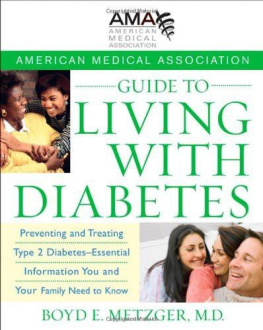DIABETES HEAD TO TOE

Note to Reader. This book is not meant to substitute for medical care of people with diabetes, and treatment should not be based solely on its contents. Instead, treatment must be developed in a dialogue between the individual and his or her physician. Our book has been written to help with that dialogue.
Drug dosage: The authors and publisher have made reasonable efforts to determine that the selection of drugs discussed in this text conform to the practices of the general medical community. In view of ongoing research, changes in governmental regulation, and the constant flow of information relating to drug therapy and drug reactions, the reader is urged to check the package insert of each drug for any change in indications and dosage and for warnings and precautions. This is particularly important when the recommended agent is a new and/or an infrequently used drug.
2018 Johns Hopkins University Press
All rights reserved. Published 2018
Printed in Canada on acid-free paper
9 8 7 6 5 4 3 2 1
Johns Hopkins University
Press 2715 North Charles Street
Baltimore, Maryland 21218-4363
www.press.jhu.edu
Library of Congress Cataloging-in-Publication Data
Names: Kalyani, Rita Rastogi, author.
Title: Diabetes head to toe : everything you need to know about diagnosis, treatment, and living with diabetes / Rita R. Kalyani, MD, MHS, Mark D. Corriere, MD, Thomas W. Donner, MD, Michael W. Quartuccio, MD.
Description: Baltimore : Johns Hopkins University Press, 2018. | Series: A Johns Hopkins Press health book | Includes bibliographical references and index.
Identifiers: LCCN 2018000282 | ISBN 9781421426471 (hardcover : alk. paper) | ISBN 1421426471 (hardcover : alk. paper) | ISBN 9781421426488 (paperback : alk. paper) | ISBN 142142648X (paperback : alk. paper) | ISBN 9781421426495 (electronic) | ISBN 1421426498 (electronic)
Subjects: LCSH: DiabetesDiagnosisPopular works. | DiabetesTreatmentPopular works.
Classification: LCC RA645.D5 K35 2018 | DDC 616.4/62dc23
LC record available at https://lccn.loc.gov/2018000282
A catalog record for this book is available from the British Library.
Illustrations by Jennifer E. Fairman, MA, CMI, FAMI, and Tim Phelps, MS, FAMI 2018, Johns Hopkins University, Art as Applied to Medicine
Special discounts are available for bulk purchases of this book. For more information, please contact Special Sales at 410-516-6936 or .
Johns Hopkins University Press uses environmentally friendly book materials, including recycled text paper that is composed of at least 30 percent post-consumer waste, whenever possible.
To the millions of people living with diabetes worldwide whose inspiring stories and determination give us hope. To my husband, Sachin, and my children, Shaan and Sonia, who are my constant source of wisdom, joy, and pride, and to my parents for always seeing what is possible.
RITA R. KALYANI
To my wife, Suzy, and childrenDominic, Molly, Sam, and Tommyfor their constant support and encouragement of my career. To my dad, who was the first person to pique my interest in diabetes, and the scores of patients I have been honored to treat who have grown my interest in this field.
MARK D. CORRIERE
To my wife, Danielle, and my childrenGabriel, Bridget, and Celiawho so enrich my life. And to my patients who have had the courage and persistence to take on this challenging disease and from whom I have learned so much.
Thomas W. Donner
To my wife, Katelyn, and son, Benjamin, who have been so supportive of my career choice. To my parents, who constantly pushed me to achieve my goals. And to all my patients, who inspire me to work harder every day.
MICHAEL W. QUARTUCCIO
PREFACE
We wrote this book for you. Chances are that you either know someone who has diabetes, are at risk of developing diabetes, or have diabetes yourself. The number of people with diabetes continues to climb dramatically, and the face of diabetes worldwide is changing rapidly. No two people with diabetes are alike. There are various types of diabetes, and some people are more likely to develop diabetes than others. An ever-increasing number of medications are available to treat this disease. While some people need insulin right away, others do not. The disease can affect many different organs in the bodyfrom head to toe and everywhere in between. Not everyone with diabetes develops the same complications or medical conditions.
The information in these pages represents the best of what we know to date. We are health professionals who have not only spent many years specializing in the comprehensive care of people with diabetes but who have also established clinical guidelines for how all health professionals should care for people with diabetes. We treat people with diabetes both in the community and in university-based centers. We are hopeful that patients, family members, teachers, physicians, nurses, dietitians, pharmacists, specialists, and anyone else who cares about the health of a person with diabetes will benefit from this book.
Diabetes is a chronic illness that relies heavily on a persons ability to self-manage his or her disease. Yet during a routine clinic visit, health care providers may be limited (for a variety of reasons) in their ability to relay the critical information that people with diabetes need to optimally manage their disease at home. Many complications of diabetes are preventable. By reading this book, we hope that people with diabetes will be better equipped to recognize early warning signs so that the appropriate measures can be taken. This will help to avoid difficulties in the future. The goal is attainable, but it starts with you.
In this book, we provide up-to-date information written in simple, easy-to-grasp sections. We emphasize the key facts that we would want any person who has diabetes (or who is interested in diabetes) to knowas if we were sitting face-to-face with you right now. The more than 130 topics in this book cover the different ways in which diabetes can affect a person from a personal, family, societal, and legal perspective. This book goes beyond describing the traditional small blood vessel complications (eye disease, kidney disease, and nerve disease) and large blood vessel complications (heart disease, stroke, and peripheral artery disease) of diabetes that, while undoubtedly important, do not fully capture how diabetes can affect the day-to-day life of someone living with the disease. The wide breadth of topics and easy accessibility of the content have the goal of empowering you with the critical knowledge you need to confidently self-manage diabetes at home and to facilitate informed discussions with your health care team.
Each topic begins with a short introduction that defines the medical conditions in plain everyday language. The technical medical terms are also included to familiarize you with them. The next section for each topic is titled What You Need to Know and outlines the important facts for each topic. The last section of each topic, titled What Does It All Mean? distills in a few sentences or bullet points the key items for each topic and the action steps you can take today. While the sections for each topic are intended to be read in the order written, you may decide to read the last section first to grasp the key points from the beginning. The topics are not meant to be extensive in length but instead, may trigger you to seek more information about a specific area of interest. You will notice that health care provider is used intentionally throughout the book in order to include physicians, nurse practitioners, dietitians, pharmacists, podiatrists, and all the other specialists who may be involved in the comprehensive care of people with diabetes.
Next page












